Physics For Civil Engineering: Unit II: Ventilation And Refrigeration
Air Conditioning Systems for Different Types of Buildings
The choice of which air conditioner system to use depends upon a number of factors including how large the area is to be cooled, the total heat generated inside the enclosed area, etc.
AIR CONDITIONING SYSTEMS FOR DIFFERENT
TYPES OF BUILDINGS
The
choice of which air conditioner system to use depends upon a number of factors
including how large the area is to be cooled, the total heat generated inside
the enclosed area, etc.
An HVAC designer would consider all the
related parameters and suggest the system most suitable for your space.
Types
of Air Conditioners
There
are various types of air conditioners like window air conditioner, split air
conditioner, packaged air conditioner and central air conditioning system.
1. Window Air Conditioning System
2.
Split Air Conditioner System
3.
Central Air Conditioning Plants
4.
Packaged Air Conditioners
1. Window Air
Conditioner
These
air conditioners are also known as unitary air conditioning systems. Window air conditioner is the most
commonly used air conditioner for single rooms.
In
this air conditioner all the components, namely the compressor, condenser,
expansion valve or coil, evaporator and cooling coil are enclosed in a single
box. This unit is fitted in a slot made in the wall of the room, or more
commonly a window sill.
One
end of the unit transports heat from indoors to the outside, while the other
blows cool air inside the house. The device is very easy to install and can be
used in almost any room that has a window. (Fig. 2.18)
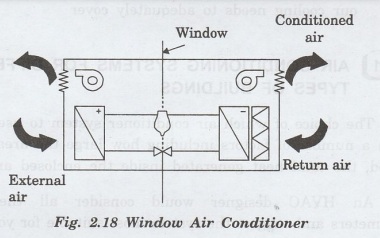
Room
air conditioners are generally available in capacities varying from about 0.5
Ton to 3 Ton.
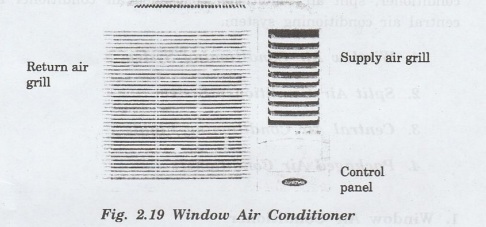
2. Split Air Conditioner
This
is one of the most popular air conditioning systems in the world. It is also
known as Ductless Air Conditioning Units
The
split air conditioner comprises of two parts:a wall-mounted indoor unit and an
exterior component.
The outdoor unit which includes
components like the compressor, condenser and expansion valve fitted outside
the room.
The
indoor unit comprises the evaporator or cooling coil and the cooling fan.
The
indoor unit sucks in hot air from the room and cools it before blowing cool air
back into the room.
On
the other hand, the outdoor unit cools the refrigerant first, before
transporting it to the secondary units (air handlers) indoors.
The
two units are connected by electrical cables and metal tubes carrying the
refrigerant.
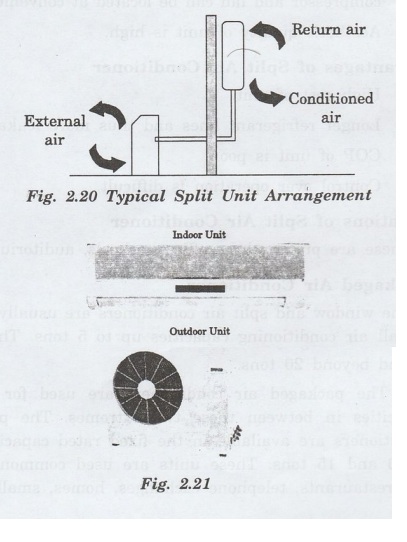
There
is no need to make any hole in the wall of the room. Further, present day split
units have aesthetic appeal and do not take up as much space as a window unit.
A
split air conditioner can be used to cool one or two rooms.
Advantages
of Split Air conditioner
•
Noiseless operation.
•
Less vibration.
•
No necessity of wall opening.
•
Occupies less space in the room.
•
Better circulation of air.
•
More
accessible for maintenance,
as condenser, compressor and fan can be located at convenient place.
•
Aesthetic quality of unit is high.
Disadvantages
of Split Air Conditioner
• High cost of unit.
•
Longer refrigerant lines and thus more leakage.
•
COP of unit is poor.
• Control over operation is difficult.
Applications
of Split Air Conditioner
These
are preferred for offices, schools, auditoriums, etc.
3. Packaged Air Conditioner
The
window and split air conditioners are usually used for the small air
conditioning capacities up to 5 tons. The central air conditioning systems are
used for where the cooling loads extend beyond 20 tons.
The
packaged air conditioners are used for the cooling capacities in between these
two extremes. The packaged air conditioners are available in the fixed rated
capacities of 3, 5, 7, 10 and 15 tons. These units are used commonly in places
like restaurants, telephone exchanges, homes, small halls, etc.
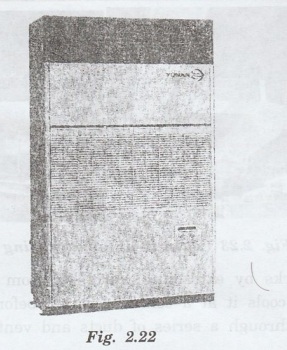
There are two possible arrangements with
the package unit.
In
the first one, all the components, namely the compressor, condenser (which can
be air cooled or water cooled), expansion valve and evaporator are housed in a
single box.
The
cooled air is thrown by the high capacity blower, and it flows through the
ducts laid through various rooms.
In the second arrangement, the
compressor and condenser are housed in one casing.
The compressed gas passes through
individual units, comprised of the expansion valve and cooling coil, located in
various rooms.
4. Central Air Conditioning System
Central
air conditioning is used for cooling big buildings, houses, offices, entire
hotels, gyms, movie theaters, factories etc.
If
the whole building is to be air conditioned, HVAC engineers find that putting
individual units in each of the rooms is very expensive making this a better
option.
This
is a fully ducted system that can either be high velocity or low velocity.
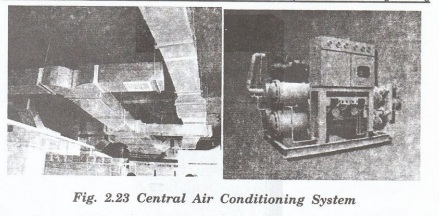
It
works by extracting warm air from different parts of the house, cools it at a
central location before distributing the cooled air through a series of ducts
and vents.
A central air conditioning system is c
is comprised of a huge compressor that has the capacity to produce hundreds of
tons of air conditioning.
Cooling
big halls, malls, huge spaces, galleries etc is usually only feasible with
central conditioning units.
5. Portable Air
Conditioner (localized cooling T requirement)
Portable
air conditioners are considered as the next generation of window units. This
type of air conditioning unit takes in air from the room and cools it, then
directs it back into the room. The e unit then vents any warm air outside by
means exhaust hose that is installed in a window. (Fig. 2.24)
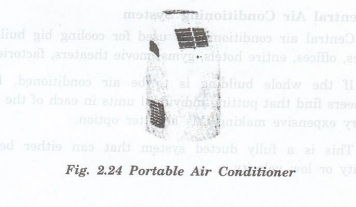
Like
window air conditioning units, portable conditioners are designed to cool only
one room. They are easy to install, versatile and an affordable option.
6. Hybrid Air Conditioning System A New Development for Energy Conservation
For
the hot and dry climate the evaporative cooling serves the purpose along with
energy conservation. On the other hand, the conventional air conditioner
renders human comfort in the hot and humid environment. Thus an air
conditioning system should provide comfort air conditioning operating as:
(i)
evaporative cooling mode during hot-dry climate.
(ii)
conventional air conditioning mode during hot-humid climate, in order to
conserve energy.
The
new system developed for the above purpose has been named as a hybrid air
conditioner. A 1.5 ton such unit takes about 1650 W in the air conditioning
mode of operation while 300 W in the evaporative cooling mode of operation. The
system is shown schematically in fig. 2.25, being self explanatory.
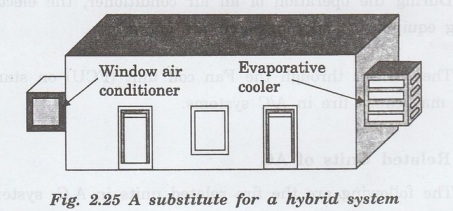
Like
hybrid cars, hybrid heat pump systems alternate between burning fossil fuels
and using electricity to run.
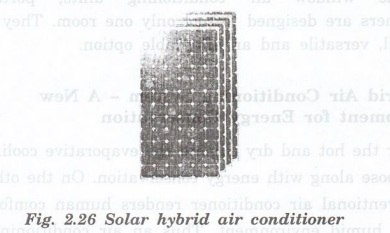
Physics For Civil Engineering: Unit II: Ventilation And Refrigeration : Tag: : - Air Conditioning Systems for Different Types of Buildings
Related Topics
Related Subjects
Physics for Civil Engineering
PH3201 2021 Regulation | 2nd Semester Civil Dept 2021 Regulation
